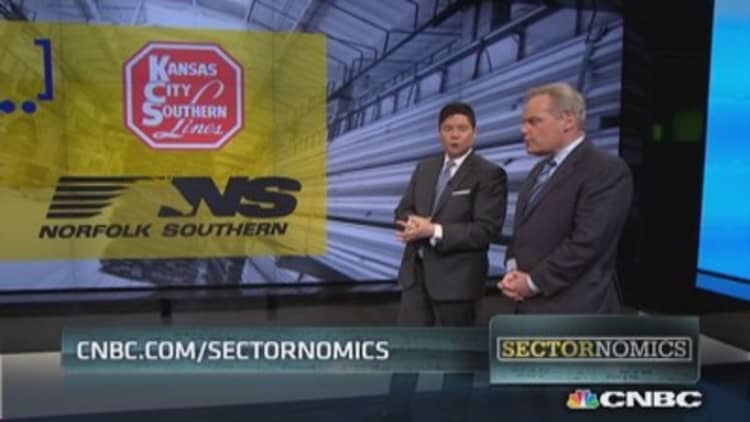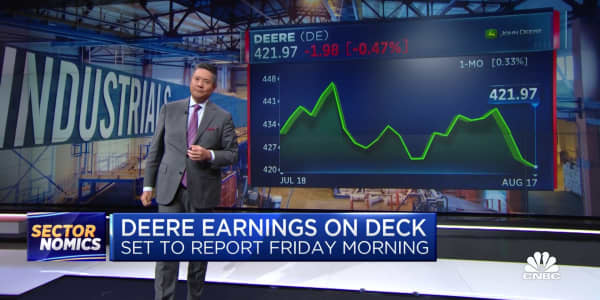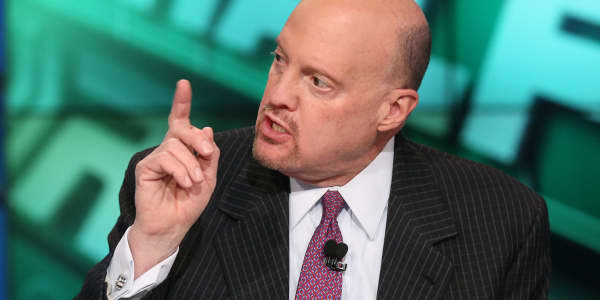It's been another harrowing week for investors, with all the major U.S. markets falling by about 1 percent between April 10 and 15. For the average investor, selloffs bring fears of another recession, but for more astute stock pickers, a market drop is often a chance to pick up stocks at a bargain.
There's one sector that investors should consider taking advantage of during a dip: U.S. industrials. If you believe that the economy will keep recovering, then this is the sector to own—it always does better when the country's fortunes improve.
Just look at its post-recession returns for proof. Between Sept.19, 2008, and March 6, 2009, America's industrial sector, which accounts for about 11 percent of the market, fell by about 55 percent, compared with 45 percent for the S&P 500. Since the market bottomed on March 6, 2009, the S&P 500 is up 149 percent, compared with 230 percent for the S&P 500 Industrials Index.
Dan Bastasic, a U.S. growth and income fund manager with IA Clarington, a Toronto-based investment management firm, was a big believer in the sector back then. Three of his fund's largest holdings at the start of 2009 were industrials. He knew that as soon as the economy got going again, the sector would outperform the broader market—and he was right.
At the moment, Bastasic is underweight the sector, but he'll be adding to his position soon, he said. He wants to see the market pull back by about 6 percent before waiting to buy more.
He's also not worried about the recent drop. All signs are pointing to an improving economy, he said, which means the sector should continue to improve. "I still really like them," he added. "They're in the right part of the cycle."
Planes, trains and automobiles
Many investors have a hard time understanding what makes up the industrial sector; it's not as easy to grasp as, say, technology or consumer staples.
To Bastasic, the industry is made up of three subsectors: transportation, capital goods and commercial and professional services.
Transportation includes aerospace and rail companies; capital goods is equipment manufacturers and some technology companies that focus on aerospace and automotive; commercial and professional services is made up of packing and waste-management operations.
Brad Sorensen, director of market and sector analysis for the Schwab Center for Financial Research, sums up the sector another way. "The best way to explain it is that it's a lot of the stuff that gets stuff done," he said.
Economically sensitive

The main reason this is an attractive space today is that industrial companies perform better when the economy is doing well. Naturally, in good times businesses are more willing to spend money on equipment upgrades and shipping, while consumers are less reluctant to buy cars and airline tickets, said Sorenson.
A lot of these companies also have high fixed costs that they have to keep paying in good times and bad, said IA Clarington's Bastasic. When revenues are less, he explained, robust margins get depressed, but when these businesses are selling more, those margins can rapidly increase.
Rail companies, for instance, can put fewer trains on tracks, but they still have to house and maintain those cars for future use. When the economy improves, they instantly get a boost to their bottom line.
"When they can start moving more product, the overall cost of the business decreases, and that increases earnings," said Bastasic.
The main risk to the sector is an economic slowdown, said Sorenson. If GDP slows, this sector will slow, too. Some companies are exposed to Europe and China as well, so it's not just American growth that investors need to worry about.
"[Anything] that would cause businesses to hold back on spending would be a problem," he said.
Read MoreBill aims to spur job growth
Still solid buys
Many investors have already figured out that the industrial sector is the place to be.
Nearly $5 billion dollars of investor money flowed into the sector in 2013, up from $1.6 billion a year earlier, and assets under management in industrial-focused exchange-traded and mutual funds have increased 314 percent between year-end 2009 and April 15 of this year, according to Lipper Research, a mutual fund data and research company.
However, now might be an ideal time to get in. The sector is down about 2 percent year-to-date, and a lot of good companies—such as railroad company CSX Corp. (NYSE: CSX) and motion-and-control technology maker Parker Hannifin (NYSE: PH)—have fallen more than that.
Part of the reason for the pullback is that the sector did so well last year; it was up 34 percent, so people are realizing gains. There's also some concern over where the markets may be headed, especially after some of the dips we've seen this year, said Matt Arnold, a St. Louis, Mo.-based analyst with Edward Jones.
The drop in sector returns and flows—the industry has experienced $2.4 billion in outflows so far this year—should be only temporary.
All signs point to a continued economic recovery, and Sorenson pointed out that thanks to hand-wringing over government shutdowns and budget deals, business investment has yet to pick up the way many had expected it to, but that should change soon.
"This cycle is different than past cycles," he said. "Business confidence has been quite depressed since the financial crisis, so spending on capital expenditures, which benefits the industrial sector, has been less than we would have expected after the recession."
Companies now have a lot of cash on their balance sheets because of that delay in spending, and investors are getting antsy; they want to see more spending, said Sorenson. That bodes well for the sector. "It's certainly an attractive place to be," he said.
Be choosy
There are two ways investors can play this sector. If you believe the entire industry will do well as the economy improves, then stick to buying an industrials-focused ETF or mutual fund. The largest ETF is the Industrial Select Sector SPDR Fund (NYSE Arca: XLI), which is down 2.5 percent year-to-date but up 21 percent over the last 12 months.
Investors can also pick stocks, but they'll have to be choosy. Some subsectors have done better than others, and it's better to buy undervalued or, at the very least, fairly valued business.
Aerospace and residential construction are two areas that should continue to improve, said Arnold, while Bastasic pointed out that the transpiration subsector as a whole is undervalued compared to its historical norm. It's trading at 7.9 times EV-to-EBITDA, compared with 8.5 times in the past.
The commercial and professional services subsector is more fairly valued. It's trading at about 9.5 times EV-to-EBITDA, but it's less volatile than other sectors because cities always need to get rid of garbage, while capital goods look the least attractive. It's trading at about 10 times EV-to-EBITDA, which is above its historical norm.
When looking for a company to buy, first decide whether you want to own a more defensive name or not. Some of the more diversified operations, like 3M (NYSE: MMM), an industrial-focused technology company, are less volatile, but they may not see as much growth on an upswing.
These companies should have a strong leadership team who can guide them through down cycles and participate in the up cycles, said Arnold. "You have to have the confidence that your company is going to participate as much as its competitors," he said. "If they don't, then that will be a problem."
Read MoreUS manufacturing extends growth after long, cold winter
Investors will have to be more active with more cyclical names, which means they'll have to buy when the going is good and sell when the cycle turns. Caterpillar (NYSE: CAT) is one of the more cyclical names that Arnold follows, because its fortunes are tied into the mining industry's fortunes.
Bastasic, who likes the less cyclical names, is also keen on companies that pay a dividend—many in the sector pay between 1.5 percent and 2.5 percent—and he wants to see high return on capital.
Cash-flow sustainability is also important, as these companies will have to eventually manage through another downturn, and profitability is also key.
Choose the right business, though, and you could see around 10 percent earnings growth if not more in this sector, said Bastasic.
He hopes to take advantage of that growth soon. "We're definitely going to be buying more," he stressed. "We're just waiting for things to come our way."






